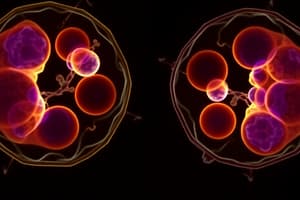Podcast
Questions and Answers
What is the primary goal of the lab discussed?
What is the primary goal of the lab discussed?
- To perform chemical reactions
- To analyze soil samples
- To understand the differences and similarities between mitosis and meiosis (correct)
- To test the effects of temperature on plant growth
The first draft of the lab report is due on Nov. 11.
The first draft of the lab report is due on Nov. 11.
True (A)
What two cell types are observed to identify stages of mitosis?
What two cell types are observed to identify stages of mitosis?
Plant and animal cells
The process of exchanging genetic material during meiosis is known as __________.
The process of exchanging genetic material during meiosis is known as __________.
Match the lab report sections with their content:
Match the lab report sections with their content:
What is the primary purpose of meiosis?
What is the primary purpose of meiosis?
Mitosis is responsible for generating haploid cells.
Mitosis is responsible for generating haploid cells.
How many chromosomes do humans have in their somatic cells?
How many chromosomes do humans have in their somatic cells?
The complete collection of all genetic information in a cell is called the ______.
The complete collection of all genetic information in a cell is called the ______.
Match the following terms with their descriptions:
Match the following terms with their descriptions:
Which of the following is true about homologous chromosomes?
Which of the following is true about homologous chromosomes?
What is the chromosomal number of an Indian muntjac deer?
What is the chromosomal number of an Indian muntjac deer?
During which phase of the eukaryotic cell cycle is DNA replication completed?
During which phase of the eukaryotic cell cycle is DNA replication completed?
Interphase occupies approximately 50% of the eukaryotic cell cycle.
Interphase occupies approximately 50% of the eukaryotic cell cycle.
What are the two main phases of the eukaryotic cell cycle?
What are the two main phases of the eukaryotic cell cycle?
During cytokinesis, division of the ______ occurs after mitosis.
During cytokinesis, division of the ______ occurs after mitosis.
Match the phases of mitosis with their descriptions:
Match the phases of mitosis with their descriptions:
What is a centromere?
What is a centromere?
Sister chromatids are formed during the G1 phase.
Sister chromatids are formed during the G1 phase.
List the five subphases of mitosis.
List the five subphases of mitosis.
The longest part of the cell cycle is ______.
The longest part of the cell cycle is ______.
During which stage of the cell cycle do chromosomes condense and the nuclear envelope begins to disintegrate?
During which stage of the cell cycle do chromosomes condense and the nuclear envelope begins to disintegrate?
Sister chromatids are pulled apart during telophase.
Sister chromatids are pulled apart during telophase.
What is the role of the kinetochore during mitosis?
What is the role of the kinetochore during mitosis?
During __________, the centromeres of all the chromosomes are lined up at the spindle's equator.
During __________, the centromeres of all the chromosomes are lined up at the spindle's equator.
Match the mitosis stages with their descriptions:
Match the mitosis stages with their descriptions:
What forms after the nuclear envelope disassembles during prometaphase?
What forms after the nuclear envelope disassembles during prometaphase?
In animal cells, centrosomes assist in the formation of spindle fibers during prophase.
In animal cells, centrosomes assist in the formation of spindle fibers during prophase.
What is the primary role of the spindle fibers during mitosis?
What is the primary role of the spindle fibers during mitosis?
The process of __________ completes cell division after mitosis by dividing the cytoplasm into two daughter cells.
The process of __________ completes cell division after mitosis by dividing the cytoplasm into two daughter cells.
Flashcards
Mitosis vs. Meiosis
Mitosis vs. Meiosis
Mitosis is cell division that creates two identical daughter cells, while meiosis creates four genetically different daughter cells.
Phases of Mitosis
Phases of Mitosis
Mitosis involves distinct phases like prophase, metaphase, anaphase, and telophase, crucial for cell division.
Plant vs. Animal Cells in Mitosis
Plant vs. Animal Cells in Mitosis
Plant and animal cells differ slightly in their mitosis process, especially in cytokinesis (the division of the cytoplasm).
Crossing Over
Crossing Over
Signup and view all the flashcards
Lab Report Sections
Lab Report Sections
Signup and view all the flashcards
Genome
Genome
Signup and view all the flashcards
Chromatin
Chromatin
Signup and view all the flashcards
Chromosome
Chromosome
Signup and view all the flashcards
Somatic Cell
Somatic Cell
Signup and view all the flashcards
Diploid Cell
Diploid Cell
Signup and view all the flashcards
Haploid Cell
Haploid Cell
Signup and view all the flashcards
Gamete
Gamete
Signup and view all the flashcards
Cell Cycle Phases
Cell Cycle Phases
Signup and view all the flashcards
Interphase
Interphase
Signup and view all the flashcards
G1 Phase
G1 Phase
Signup and view all the flashcards
S Phase
S Phase
Signup and view all the flashcards
G2 Phase
G2 Phase
Signup and view all the flashcards
M Phase
M Phase
Signup and view all the flashcards
Mitosis
Mitosis
Signup and view all the flashcards
Cytokinesis
Cytokinesis
Signup and view all the flashcards
Sister Chromatids
Sister Chromatids
Signup and view all the flashcards
What does 'prophase' mean?
What does 'prophase' mean?
Signup and view all the flashcards
What are kinetochores?
What are kinetochores?
Signup and view all the flashcards
What is the role of centrosomes?
What is the role of centrosomes?
Signup and view all the flashcards
What is the mitotic spindle?
What is the mitotic spindle?
Signup and view all the flashcards
What happens in prometaphase?
What happens in prometaphase?
Signup and view all the flashcards
What is a metaphase plate?
What is a metaphase plate?
Signup and view all the flashcards
What is anaphase?
What is anaphase?
Signup and view all the flashcards
What happens in telophase?
What happens in telophase?
Signup and view all the flashcards
What is cytokinesis?
What is cytokinesis?
Signup and view all the flashcards
Study Notes
Lab 12: Mitosis and Meiosis
-
Lab Skills will be held on Monday, October 28th for 20 minutes
-
Students will be assigned a 20-minute timeslot at a station.
-
Station assignments are random and materials at each station may differ from others.
-
Lab Skills (cont.)
- Lab will have 3 identical set ups in each room
-
Table 1 = Station 1, Table 2 = Station 2, Table 3 = Station 3
-
Table 4 = Station 1, Table 5 = Station 2, Table 6 = Station 3
-
Lab Skills (cont.)
-
Students will answer 4 questions
- Microscopy (2 questions): Identify images on slides
- Pipetting & Weighing (1 question): Perform balance, transfer volume of solution and weighing
- Spectrophotometry (1 question): Measure absorbance/transmittance at different WVs, using technique of blanking and changing mode
-
Lab Report
- The subject of the lab report is Photosynthesis.
- Exercises from Lab 10 will be reviewed
- Cover pages for lab reports are required
- Include sections titled Introduction; Materials and Methods; Results; Discussion and References
- Due dates:
-
First draft: Nov 8th (Friday)
-
Feedback returned: Nov 11th (Monday)
-
Final draft: Nov 22nd (Friday)
-
Goals of this lab
- Students will understand the differences and similarities between mitosis and meiosis
- Identify phases of mitosis in plant and animal cells
- Explain mitotic differences between plant and animal cells
- Understand the importance of crossing over
-
Mitosis vs. Meiosis
- Mitosis is part of the cell cycle and creates two identical daughter cells.
- This occurs when an organism is growing, or cells need replacement
- Meiosis occurs in the life cycle of sexually reproducing organisms, with reduction of diploid chromosome numbers to haploid.
-
Chromosomes
- Genome is the complete collection of genetic information of a cell.
- DNA exists as chromatin (DNA and histone protein complex) and chromosomes (highly condensed chromatin).
- Chromosomal numbers vary amongst organisms. Some examples include: Human (23n=46), Chimpanzee (24n=48), Apple (17n=34), Hermit crab (127n=254), Indian muntjac deer(1n=2).
- Somatic cells (non-reproductive cells) have homologous chromosome pairs.
- Gametes (reproductive cells such as sperm and ova) have half the number of chromosomes as somatic cells.
-
Chromatin vs. Chromosome
-
There is a visual that shows the difference between the two forms of DNA.
-
Homologous Chromosomes
-
Have similar structures consisting of size, shape, centromere location and hereditary information
-
Carries information of the same traits.
-
One inherited from each parent.
-
Eukaryotic Cell Cycle: Two Major Phases
-
Interphase occupies 90% of cell cycle and includes:
- Cell growth
- Metabolic reactions
- DNA duplication
- Preparation for mitosis
-
Mitotic Phase (M Phase)/Cell Division includes:
- Microtubule apparatus called the mitotic spindle forms and attaches to replicated DNA.
- Spindle moves chromosomes apart to produce cells with identical genetic information.
-
Stages of Mitosis
- A continuous process, but described in 5 sub-phases (prophase, prometaphase, metaphase, anaphase, telophase)
- Occurs after interphase and includes division of the nucleus
- Separation of sister chromatids
-
Cytokinesis
- Division of the cytoplasm
- Occurs at the end of mitosis (during anaphase and telophase) to create roughly equal halves
- Mechanism for Cytokinesis
- Animal cells: actin filament contraction to create cleavage furrow
- Plant cells: formation of a cell plate by vesicles from golgi apparatus
-
Results of Mitosis
- Two new daughter cells form, each with the same chromosome number as the parent cell.
- Chromosomes return to their unduplicated forms.
-
Exercise 7.2 Onion Root Tips
- Examine onion root tips for cells in different phases of mitosis (including Interphase, Mitosis, Prophase, Prometaphase, Metaphase, Anaphase, Telophase, Cytokinesis), and draw all phases observed.
-
Allium (onion) root tip, L.S., 40X & 100X
-
Specific images of onion root tips, at different magnification levels.
-
Whitefish Blastula, Section, 40 & 100X
-
Images at differing magnification levels
-
Whitefish Interphase, Prophase, Metaphase, Anaphase, Telophase, and Cytokinesis, Section images at 400X
- Images of whitefish cells at 400X for each mitotic phase.
-
Exercise 7.3 Animal Cells
- Cells to be examined are to be animal cells, and identify the different phases (interphase, mitosis, prophase, prometaphase, metaphase, anaphase, telophase, and cytokinesis).
- Questions will analyze differences between animal mitosis and plant mitosis
-
Meiosis and the life cycle of sexually reproducing organisms
- The alternation of meiosis and sexual reproduction (fertilization) is a fundamental mechanism in preserving the chromosome number in sexually reproducing organisms.
-
Meiosis occurs in various ways in fungi, plants, and animals, with differences in the timing of meiosis and fertilization across these eukaryotic groups.
-
Meiosis in Animals vs Plants
- Only in germ cells in animals, producing gametes (n)
- Meiosis produces haploid gametes
- During fertilization a zygote forms via gamete fusion
- Somatic cells are composed of two sets of chromosomes, one from each parent
-
Plants: only in gametangia (specialized structures in adult sporophyte)
- Spores are produced (n)
- Gametophyte generation forms following mitosis of the spores (n)
- Produces haploid gametes
- Zygote forms and undergoes mitosis to form a sporophyte
-
The Stages of Meiosis
-
Meiosis has two sequential cell divisions (Meiosis I and Meiosis II).
- Meiosis I: reduces chromosome number; DNA replication happens beforehand and separate homologous pairs
- Meiosis II: separates replicate sister chromatids, no preceding DNA replication.
- Stages: Prophase I, Metaphase I, Anaphase I, Telophase I, Prophase II, Metaphase II, Anaphase II, Telophase II
-
Crossing over
-
Occurs during prophase I of meiosis.
-
Non-sister chromosomes exchange segment of their DNA during crossing over.
-
This exchange creates variation in offspring using the result of homologous chromosomes
-
Exercise 7.4 Modeling Meiosis
-
Model the stages of Meiosis
-
Table 7.1 (PostLab 12) needs to be filled out
-
Comparison of mitosis and meiosis
- There are two distinct features found in Meiosis that are not present in mitosis; including synapsis and reduction division.
- Synapsis is the process that draw homologous chromosomes together and crossing over occurs.
- Reduction division occurs when DNA replication happens twice but meiosis happens twice and halving the genetic material present that ultimately passed to the gametes.
-
Spore Formation and Crossing Over (Sordaria)
- Sordaria fungal life cycles predominantly haploid.
- Two strains (different spore colours) fuse to from a diploid zygote
- Diploid zygote creates haploid cells and undergo meiosis
- Eight haploid cells form as the result of a round of meiosis and mitosis; the spore color phenotype will match the genotype
- If no crossing over, spores on each side will be the same color
- Ascus sac that surrounds the ascospores and the analysis of the ascospores within
-
Exercise 7.5 Meiosis in Sordaria fimicola
- Students will observe crossing over in images of Sordaria fungi
- Questions and Table 7.2 must be completed
-
Parental and Crossover Phenotypes
- Images of Sordaria asci with different phenotypic results displayed from non-crossing over, and crossing over.
-
Exercise 7.5 Crossing over in Sordaria
- The images included in this section show examples of non-crossing over; crossing over, and potential images of the intermediate phases
-
Summary of Outputs
-
Create flashcards for all necessary terminology.
-
Submit definitions in your own words with pictures for 7.2, 7.3 and tables 7.1, 7.2.
-
Review and assess your knowledge on important concepts
Studying That Suits You
Use AI to generate personalized quizzes and flashcards to suit your learning preferences.
Related Documents
Description
Test your knowledge on the concepts of mitosis and meiosis with this quiz. It covers critical aspects such as cell types, genetic material exchange, and chromosomal numbers. Perfect for biology students looking to strengthen their understanding of cellular processes.




